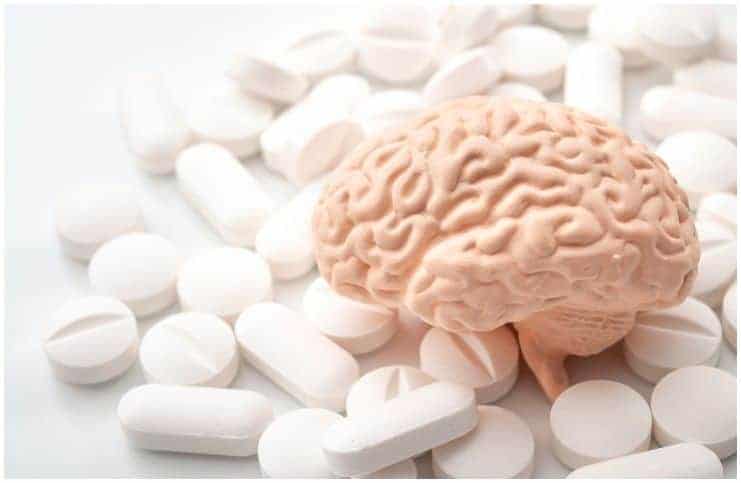Adrafinil
It is a synthetic nootropic compound that improves alertness and wakefulness while reducing the effects of fatigue and drowsiness.
Also, it is worth noting that no precise method has yet been defined for the functionality of this nootropic. However, it is thought that it stimulates the release of glutamate, hence, improving perceptive and cognitive abilities in human beings.
Moreover, this drug prevents the breakdown of dopamine, a neurotransmitter that regulates sleep, improves mood, and reduces stress. In addition, it is believed that this synthetic nootropic increases the production of hypocretin, a potent neurotransmitter that helps to control how alert and awake a person feels.
It was originally developed by Louis Lafon Laboratories in France. In the present day, it can legally be acquired in the US without a doctor’s prescription.
The recommended dosage varies between 300-1200 mg per day, taken orally. It is a very effective nootropic, thus, it is a good idea to give your body time to adjust by starting with a lower dose and to see how your body reacts.
When administered orally on an empty stomach, the effects of this drug can be felt about 45 to 60 minutes afterword.
Uses
It is especially considered to be good at increasing daytime alertness and wakefulness, plus, it positively affects the energy levels, mood, reaction time, and motivation. Also, sleep apnea (when a person’s breathing is interrupted during sleep) is ameliorated through the use of this nootropic.
Side Effects And Precautions
Common side effects of using this drug include:
- many users have reported an increase in inner restlessness and agitation;
- increase in liver enzyme counts;
- insomnia;
- appetite reduction;
- nausea;
- mild headaches.
Serious side effects (very rare) may include:
- rapidly changing moods;
- unusual bruising or bleeding;
- increased urination and thirst; trouble in urinating;
- blurred vision or other vision problems;
- confusion; mental depression;
- chest pain; shortness of breath;
- black stools;
- uncontrolled movements of the mouth, face, or tongue;
- problems with memory;
- a sore throat;
- shaking or trembling; chills or fever; fainting;
- unusual weakness or tiredness.
Modafinil
It is a synthesized eugeroic blockbuster drug for the treatment of excessive daytime sleepiness (characterized as a chronic feeling of overwhelming daytime fatigue) associated with narcolepsy.
Created in the 1970s in France, it is sold in the United States under the brand name of Provigil, which must be prescribed by a healthcare professional.
It is occasionally classified as a “smart drug” because it’s known to improve the performance of an individual who is impaired by a lack of sleep and fatigue.
As a stimulant, it is not as effective as amphetamine (a synthetic stimulant-type medication), however, it does produce similar effects to the more potent synthetic stimulants (drugs), only at a less intense level of the central nervous system arousal.
Provigil works by stimulating the central system and improving the activity of histamine (an organic nitrogenous compound), which in turn helps neurotransmitters work better.
This drug is classified as a Schedule IV drug defined by the US DEA as drugs with a low risk of dependence and low potential for abuse.
Uses
Healthcare professionals usually prescribe the drug to improve wakefulness in people who are experiencing excessive sleepiness due to shift work sleep disorder, obstructive sleep apnea, or narcolepsy. It is proved in many studies to be useful in the treatment of narcolepsy, a long-term neurological disorder characterized by uncontrollable attacks of daytime sleepiness.
Adults who have this sleep disorder may take 200 mg to 600 mg, orally, every morning or the same dose may be divided and taken two times per day.
Side Effects And Precautions
Common side effects of using this drug may include:
- nausea;
- nervousness;
- headaches;
- back pain.
Rare side effects may include:
- unusual weakness or tiredness;
- chest pain;
- confusion;
- mental depression;
- tarry stools;
- unsteadiness;
- shortness of breath;
- blurred vision;
- fever;
- rapidly changing moods;
- dizziness;
- memory problems;
- increased urination;
- increased thirst;
- a sore throat;
- uncontrolled movements of the face;
- shaking;
- unusual bleeding;
- trouble in urinating.
Because it increases the levels of dopamine, some scientists suggest that this drug similarly affects the brain as cocaine and amphetamines.
Avoid consuming alcoholic beverages while using this medication. Because it can cause dizziness or blurred vision, take extra care when using machines or drive a car.
There are no adequate studies in pregnant and breastfeeding women for determining the risks, thence, stay on the safe side and avoid using this drug.
More importantly, this medication should be used with caution in individuals with a history of:
- abuse of drugs, alcohol, or illicit substances;
- depression, psychosis, or mania.
Adrafinil vs Modafinil – Which One Is The Best Nootropic?
Chemically speaking, the structures of both these nootropics are very similar, however, adrafinil is a prodrug for modafinil. This actually means that intaking adrafinil leads to a higher concentration of modafinil in the body.
Both have plenty of side effects, including feelings of anxiety and irritability as well as gastrointestinal distress and nausea. But, according to data, Provigil is safer on the liver and lower doses are needed to achieve the same level of effectiveness as adrafinil.
Images credit – Shutterstock
READ THIS NEXT: Pantoprazole vs Omeprazole
